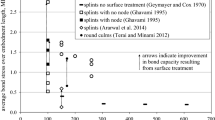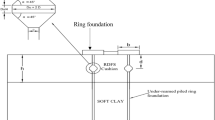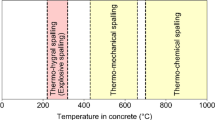Abstract
This paper describes and analyses the performance of two structural strengthening solutions for rubble stone masonry walls. The strengthening solutions are characterised by: sprayed micro-concrete steel reinforced layers on both lateral faces of the walls, with transversal steel ties through the thickness of the specimens, not in contact with the base of the loading systems; sprayed micro-concrete steel reinforced layers on lateral faces of the specimens, without transversal steel ties but in contact with the base of the loading systems. For the first solution three specimens were tested under axial compression load and three under compression-shear load, and for the second solution three specimens were tested under axial compression load. The results are compared with unstrengthened (reference) specimens. Strengthening solutions of this nature have been used in the rehabilitation of old masonry walls in Portugal, particularly in Lisbon downtown, and in the rehabilitation of some Azores buildings after the 1998 earthquake.
Similar content being viewed by others
References
Appleton J (2003) Reabilitação de edifícios antigos—patologias e tecnologias de intervenção (in Portuguese). Edições Orion, Lisbon
Candeias P, Coelho E, Costa A, Silva V (2004) Ensaios em plataforma sísmica de modelos reduzidos 1:3 de edifícios de 4 andares em alvenaria não reforçada (in Portuguese). Sísmica 2004 - 6° Congresso Nacional de Sismologia e Engenharia Sísmica. Universidade do Minho, Guimarães
Comité Européen de Normalisation (2005) Eurocode 6: design of masonry structures (CEN, 2005). Part 1–1 : general rules for reinforced and unreinforced masonry. EN 1996-1-1. CEN, Brussels
Costa A, Candeias P, Massena B, Silva V (2004) Reforço sísmico de edifícios de alvenaria com aplicação de reforços de fibra de vidro (in Portuguese). Sísmica 2004—6° Congresso Nacional de Sismologia e Engenharia Sísmica. Universidade do Minho, Guimarães
Costa A (2000) Caracterização das propriedades mecânicas das paredes de alvenaria tradicional das casas da ilha do Faial, Açores (in Portuguese). REPAR 2000—Encontro Nacional sobre Conservação e Reabilitação de Estruturas. LNEC, Lisbon
Costa A, Arêde A, Costa A, Guedes J, Silva B (2010) Experimental testing, numerical modeling and seismic strengthening of traditional stone masonry: comprehensive study of a real azorean pier. Bull Earthq Eng. doi:10.1007/s10518-010-9209-3. Published online: 16 September 2010
Estévez D (2009) Experimental and numerical analysis of stone masonry walls strengthened with advanced composite materials. PhD Thesis. Universidad del País Vasco, Bilbao
Instituto Nacional de Estatística (2003) Recenseamento geral da população e da habitação (INE, 2003). Censos 2001 (in Portuguese). Lisbon, 2003
Mendes N, Lourenço P (2010) Seismic assessment of masonry “Gaioleiro” buildings in Lisbon, Portugal. J Earthq Eng 14(1): 80–101
Nero J, Appleton J, Gomes A (1994) As argamassas tradicionais no parque edificado de lisboa: uma colaboração para o seu conhecimento (in Portuguese). 2° Encontro sobre Conservação e reabilitação de edifícios. LNEC, Lisbon
Oliveira C, Correia H, Lucas A, Oliveira H (2000) Um estudo sobre o comportamento sísmico de edifícios de alvenaria tradiciona (in Portuguese)l. REPAR 2000—Encontro Nacional sobre Conservação e Reabilitação de Estruturas. LNEC, Lisbon
Pinho F (2008) Paredes de edifícios antigos em Portugal (in Portuguese). Colecção Edifícios. N° 8. LNEC, Lisbon
Pinho F (2007) Paredes de alvenaria ordinária—estudo experimental com modelos simples e reforçados (in Portuguese). PhD Thesis. Engenharia Civil - Ciências da Construção. DEC-FCT/UNL, Lisbon
Pinho F, Baião M, Lúcio V, Faria P (2008a) Experimental research on rubble stone masonry walls. HMC08—Historical Mortars Conference. LNEC, Lisbon
Pinho F, Baião M, Lúcio V (2008b) Experimental analysis of rubble stone masonry walls strengthened with reinforced micro-concrete layers and transversal ties. Azores 1998—International Seminar on Seismic Risk and Rehabilitation of Stone Masonry Housing. Horta, Azores
Roque J, Lourenço P (2003) Caracterização mecânica de paredes antigas. Um Caso de Estudo no Centro Histórico de Bragança (in Portuguese). Revista do Departamento de Engenharia Civil da Universidade do Minho, no. 17, pp 31–42
Valluzzi M, Porto F, Modena C (2001) Behaviour of multi-leaf stone masonry walls strengthened by different intervention techniques. Historical Constructions, Guimarães
Vasconcelos G, Lourenço P (2004) Análise experimental do comportamento de paredes de alvenaria não reforçada sob acções cíclicas no plano (in Portuguese). Sísmica 2004—6° Congresso Nacional de Sismologia e Engenharia Sísmica. Universidade do Minho, Guimarães
Veiga M, Aguiar J, Silva A, Carvalho F (2001) Metodologias para a caracterização e conservação de argamassas de revestimento de edifícios antigos (in Portuguese). Final report of the Project Oldrenders, jointly funded by the Agência de Inovação. Lisbon
Author information
Authors and Affiliations
Corresponding author
Rights and permissions
About this article
Cite this article
Pinho, F.F.S., Lúcio, V.J.G. & Baião, M.F.C. Rubble stone masonry walls in Portugal strengthened with reinforced micro-concrete layers. Bull Earthquake Eng 10, 161–180 (2012). https://doi.org/10.1007/s10518-011-9280-4
Received:
Accepted:
Published:
Issue Date:
DOI: https://doi.org/10.1007/s10518-011-9280-4




